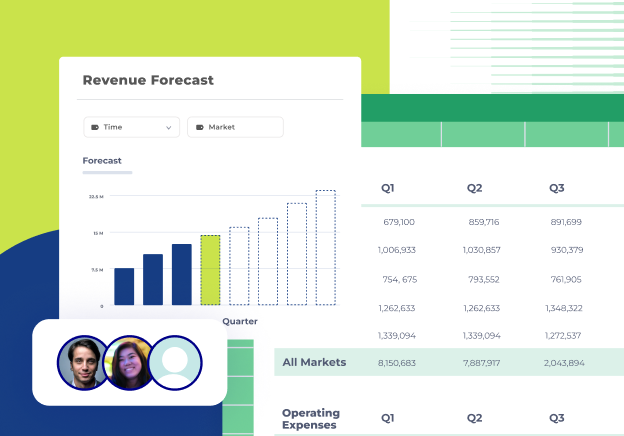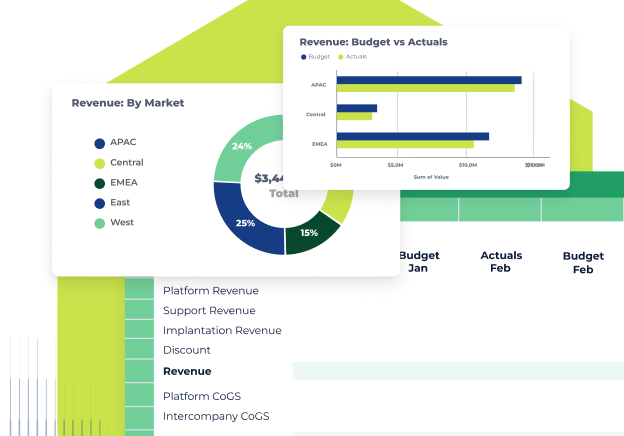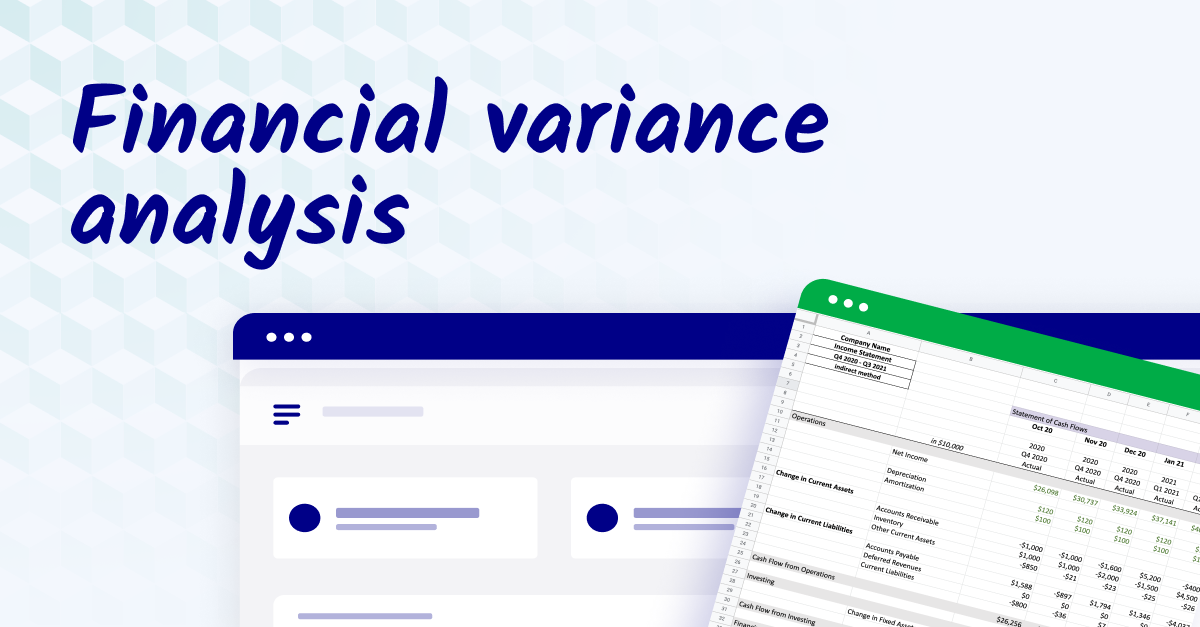What is AI for FP&A?
AI for FP&A merges intelligent technologies with core financial processes to automate manual tasks, generate more accurate forecasts, and surface insights quickly. This shift turns FP&A from a reactive, reporting-heavy discipline into a forward-looking, strategic finance partner for the business.
AI functions as both a digital assistant and an analytical amplifier. It handles tasks like:
- Data processing: Automatically gathers, cleans, and organizes financial data
- Pattern recognition: Identifies anomalies and trends across large data sets
- Predictive modeling: Projects outcomes based on historical and real-time inputs
- Decision support: Recommends actions grounded in data
Types of AI used in FP&A
Finance teams typically move through different stages of AI adoption:
- Automation: This stage focuses on eliminating manual, repetitive tasks through robotic process automation (RPA). Think of invoice processing, reconciliations, or data entry. Automation improves accuracy and frees up time for strategic work—but doesn’t involve true “intelligence.”
- Predictive and guided analytics: At this stage, teams adopt machine learning (ML), deep learning, and neural networks to identify patterns, generate forecasts, and guide decisions. These tools surface insights from historical and real-time data, helping analysts ask better questions and test scenarios faster.
- Autonomous analytics: Here, AI tools generate and refine forecasts without constant human input. Models continuously learn from new data—adjusting assumptions, detecting anomalies, and surfacing risks in real time. Finance teams begin to rely on these dynamic models to respond more quickly to changing business conditions.
- Cognitive or agentic AI: Here, AI tools generate and refine forecasts without constant human input. Models continuously learn from new data—adjusting assumptions, detecting anomalies, and surfacing risks in real time. Finance teams begin to rely on these dynamic models to respond more quickly to changing business conditions.
Robotic process automation
Robotic process automation (RPA) uses bots to perform rule-based financial tasks, like data entry, reconciliations, and routine reporting, with speed and precision. Once configured, these bots run continuously and without errors, improving consistency and saving time.
In FP&A, RPA streamlines workflows such as budget consolidation by collecting inputs from multiple departments and standardizing them into a single format. It also automates variance analysis, flagging deviations between actuals and forecasts in real time.
By offloading repetitive processes, RPA gives finance professionals more bandwidth to focus on work like scenario modeling and business partnering, where human judgment adds the most value.
Predictive analytics
Predictive analytics leverages historical financial data to forecast future outcomes with far greater accuracy than traditional methods. While conventional forecasting often relies on averages or trendlines, AI models analyze dozens of variables and surface complex relationships that would otherwise go unnoticed.
These systems learn continuously, updating projections as new data becomes available. For example, an AI model might detect that certain economic shifts reliably boost sales of a specific product, then factor that insight into future forecasts automatically.
This adaptive approach is especially valuable in fast-changing environments, giving finance leaders more confidence in revenue, expense, and cash flow planning—and helping them steer the business with greater precision.
Machine learning and deep learning
Machine learning (ML) algorithms learn from financial data without being explicitly programmed. They spot patterns in revenue, expenses, and historical trends—then use that information to generate increasingly accurate forecasts over time. For example, ML can analyze sales data and economic conditions to refine quarterly revenue predictions or categorize thousands of transactions in seconds.
Deep learning is a type of ML that uses layered neural networks to analyze unstructured financial data—like earnings calls or market news. Neural networks mimic how the human brain processes information, using layers of nodes to map relationships in data. In FP&A, these models help with tasks like cash flow forecasting and anomaly detection, especially when dealing with volatile or fast-changing business environments.
Natural language processing
Natural language processing (NLP) is a foundational AI capability that helps finance teams interact with data using everyday language. Instead of writing complex formulas or SQL queries, users can ask, “What was our Q2 marketing spend versus budget?” or “Which departments exceeded forecasted expenses by more than 10 percent?”
This lowers the barrier to insights. With NLP, non-technical stakeholders can access financial information directly, democratizing data and reducing reliance on analysts for routine reporting.
NLP also powers automated reporting and communication. These systems summarize financial trends, analyze unstructured data like earnings call transcripts or market news, and generate written explanations for budget variances. This reduces the time finance teams spend on manual report preparation each cycle.
Agentic AI
Agentic AI builds on NLP and other technologies to serve as a proactive financial assistant. Rather than waiting for questions, it detects trends, flags anomalies, and surfaces insights in real time—often within tools finance teams already use, like Slack or Microsoft Teams.
These agents respond to questions like “What’s driving our marketing variance this quarter?” by returning a detailed breakdown of drivers, implications, and even recommended actions.
Agentic AI offers:
- Conversational access: Get answers in plain language
- Proactive monitoring: Detect shifts and anomalies without prompting
- Actionable insights: Summarize findings and suggest next steps
- Seamless integration: Operates inside collaboration tools and financial platforms
Unlike static dashboards, Agentic AI continuously monitors performance data and alerts decision-makers to risks or opportunities. It shifts finance from reactive reporting to forward-looking strategic guidance—empowering teams to act faster and smarter.
Benefits of using AI in financial planning & analysis
AI helps finance teams by addressing core pain points like slow processes, fragmented data, and limited bandwidth, improving accuracy, speed, and insight.
Speeds up analysis and decision-making
AI analyzes data in seconds, revealing patterns and connections that might take days to uncover manually. This enables faster, better-informed decisions, whether you're adjusting forecasts, reallocating budgets, or responding to market shifts.
Advanced models also support real-time scenario analysis. Teams can test assumptions and explore outcomes on the fly, without building every model from scratch.
Improves workforce optimization
AI handles tedious tasks like data aggregation, categorization, and report generation, freeing finance professionals to focus on high-value work—like identifying strategic opportunities or advising business leaders.
It also surfaces emerging trends, recommends new analytical paths, and generates visuals or narratives that make insights easier to digest and act on. This elevates finance’s influence across the organization.
Reduces human error
Unlike human analysts who may introduce inconsistencies when tired or rushed, AI systems maintain perfect accuracy when processing massive volumes of financial information. This is especially critical for reconciliations, variance analysis, and month-end close, where precision drives strategic decisions.
It also enforces standardized methodologies across teams, ensuring consistent categorization and allocation. That improves data quality and gives leadership more reliable inputs for planning and resource allocation.
Enhances strategic alignment and foresight
Perhaps most importantly, AI strengthens FP&A’s ability to anticipate change and guide the business forward. By continuously learning from historical and real-time data, AI models offer early warnings, identify underperforming areas, and suggest corrective actions—often before human analysts would spot them.
This positions FP&A not just as a reporting function, but as a proactive, insight-driven partner to leadership. This leads to faster decisions, better outcomes, and a finance team that’s not just keeping up—but driving what’s next.

Different ways to use AI to improve FP&A processes
Most organizations adopt AI capabilities incrementally, starting with those that deliver quick wins and build trust in the technology. Here are some key ways to implement artificial intelligence into your FP&A workflows:
Variance analysis
AI streamlines variance analysis by instantly comparing actuals to budgets and surfacing the most impactful deviations—no manual digging required. It flags anomalies across thousands of accounts and provides data-backed explanations in seconds.
More than just highlighting what changed, AI identifies why. It can pinpoint revenue shortfalls tied to multiple factors—like delayed launches, supply chain issues, or pricing pressures—delivering context that traditional methods often miss.
This depth of insight helps finance leaders move beyond reporting variances to address their root causes, making variance analysis a driver of strategy, not just a box to check.
Anomaly flagging
AI continuously scans financial data to detect unusual patterns that may signal errors, fraud, or emerging risks. By learning what “normal” looks like across metrics, it flags deviations that warrant a closer look before they become bigger problems.
These systems improve over time. For instance, if the AI repeatedly sees a seasonal spike in expenses, it will learn to treat that as expected, reducing false alarms and focusing attention where it’s truly needed.
Real-time, intelligent monitoring helps finance teams respond faster and more confidently to potential issues.
Scenario modeling
AI takes scenario planning beyond basic what-if analysis to model hundreds of possible futures in seconds. Instead of building each scenario manually, AI platforms generate detailed projections based on a wide range of variables and assumptions.
These models can factor in complex, interdependent inputs like interest rates, commodity prices, market shifts, or consumer trends all at once to offer a deeper, more dynamic view of potential outcomes. With this level of simulation, finance leaders can build stronger contingency plans and identify new opportunities before conditions change.
Risk management
AI turns risk management into a real-time, proactive function. Instead of relying on periodic reviews, AI continuously monitors financial and operational data to detect shifts in risk exposure across currency, credit, operations, and strategy.
Machine learning uncovers hidden correlations that might otherwise go unnoticed. For instance, it might link increased churn to specific service interactions, flagging a potential revenue risk early.
With this predictive insight, finance leaders can address issues before they escalate, moving from reactive risk response to a more resilient, forward-looking strategy.
Collaborative planning
Collaborative AI financial planning enhances cross-functional alignment by creating a unified data foundation that maintains data integrity across departments. With consistent assumptions and shared visibility, teams can plan from the same financial truth, eliminating the disconnects that often slow down strategic decision-making.
AI also uncovers hidden dependencies across plans. For example, it might reveal how marketing campaign timing impacts inventory, production schedules, and cash flow—insights that help leaders connect the dots across business units.
By preserving data integrity and revealing interdependencies, AI positions finance to lead more integrated, forward-looking planning across the organization.
AI forecasting
AI forecasting marks a major shift from static, rules-based models to adaptive, data-rich forecasting. Unlike traditional methods, AI systems continuously learn from actual results and adjust in real time for more accurate revenue, expense, and cash flow projections, even in volatile markets.
These models also integrate both structured and unstructured data, pulling insights from sources like news, social media, and even weather. For instance, a spike in positive sentiment about a product launch might automatically boost projected sales.
AI forecasting incorporates inputs and learns from outcomes to deliver projections that are not only more accurate but more responsive to real-world conditions.
Plain language mapping
AI-powered natural language interfaces allow finance teams to interact with data using everyday questions—no SQL or formulas required. Ask, “What were our top five expenses last quarter?” and get a clear, actionable answer.
The system translates plain language into data queries and can even visualize results, like charting year-over-year margin trends across regions or highlighting departments that exceeded their budgets by more than 10%. This makes insights easier to access and share, especially for non-technical stakeholders.
Generative AI
One in five organizations are currently implementing or have already implemented Gen AI in their finance processes. Generative AI can help automatically produce reports, commentary, and presentations grounded in data analysis. These tools generate clear, narrative explanations of financial results, highlighting trends, variances, and strategic takeaways.
Finance leaders can spend less time explaining the past and more time shaping the future. They can quickly review, refine, and build on AI-generated content to deliver sharper, more strategic communication.
Common challenges with AI for FP&A
Successfully adopting AI in financial planning and analysis requires more than just choosing the right AI-powered FP&A tools. It means planning for implementation challenges upfront.
Ensuring data integrity and security
AI is only as reliable as the data it analyzes. Without a strong data integrity procedure, insights are flawed—and trust erodes fast. Finance leaders can prioritize robust data governance before scaling AI. Common data quality issues include:
- Format inconsistencies across systems
- Incomplete or outdated records
- Duplicated entries
- Weak access controls
Security is just as critical. Financial data often includes sensitive insights about company strategy and performance. Effective AI adoption requires a balance: protecting sensitive data while keeping it accessible enough to power analysis.
Bridging the technical skills gap
A common barrier to AI adoption in FP&A is the perceived need for deep technical expertise. Most finance professionals aren’t trained in data science or machine learning—but that doesn’t mean they can’t work effectively with AI tools.
In reality, what’s needed isn’t coding knowledge, but data literacy and analytical fluency. Finance teams should be equipped to interpret AI outputs, ask the right questions, and connect insights to strategic goals.
To build that capability, focus on practical, business-aligned upskilling. Training doesn’t have to be overwhelming—it just needs to target the right areas:
- Understanding how AI models generate forecasts and recognize patterns
- Interpreting AI-driven insights in context, including risks, anomalies, and opportunities
- Communicating those insights clearly to cross-functional stakeholders
The goal isn’t to turn finance teams into engineers—it’s to empower them as confident, informed users of AI. With the right foundation, finance can lead the charge in AI-driven planning, reducing reliance on IT and strengthening its role as a strategic partner.
Integrating easily with financial systems
AI is most effective when it works with your existing tools—not around them. But integration can be a major hurdle. Legacy systems, data silos, and compatibility issues often slow down deployment and limit results.
The solution starts with infrastructure. Investing early in data integration, through APIs and middleware, lays the groundwork for seamless adoption.
Looking to the future of AI in FP&A
AI is shifting FP&A from a reporting-heavy function to a strategic driver of business decisions. As these technologies become more powerful and more accessible, finance teams that adopt them early will gain a lasting edge in speed, accuracy, and strategic insight.
One major trend: AI is no longer a standalone tool. Embedded AI capabilities are becoming standard in financial platforms, allowing teams to tap into advanced analytics directly within their existing workflows. This approach reduces friction and speeds up adoption by meeting finance teams where they already work.
Democratization is also accelerating. Cloud-based platforms, pre-built models, and no-code tools of enterprise-grade AI are allowing mid-sized and smaller companies to increase value without requiring deep technical expertise.
Cube helps finance teams do exactly that. By embedding AI directly into tools like Excel and Google Sheets, it accelerates AI adoption without the disruption of starting from scratch.
Ready to see how Cube can simplify your AI financial planning? Sign up for a demo today.



.png)









.png)

![AI for FP&A: The complete guide [2025]](https://www.cubesoftware.com/hubfs/EBook%20Cover%20(32).png)


.png)

![13 best variance analysis software [2026]](https://www.cubesoftware.com/hubfs/P%26L%20Variance%20report%20in%20Cube.png)